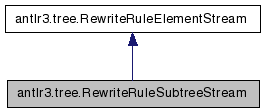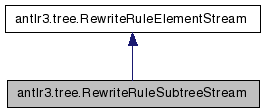antlr3.tree.RewriteRuleSubtreeStream Class Reference
Internal helper class. More...


Public Member Functions | |
| def | nextNode |
| Treat next element as a single node even if it's a subtree. | |
| def | dup |
| When constructing trees, sometimes we need to dup a token or AST subtree. | |
Detailed Description
Internal helper class.
Definition at line 2745 of file tree.py.
Member Function Documentation
| def antlr3.tree.RewriteRuleSubtreeStream.nextNode | ( | self | ) |
Treat next element as a single node even if it's a subtree.
This is used instead of next() when the result has to be a tree root node. Also prevents us from duplicating recently-added children; e.g., ^(type ID)+ adds ID to type and then 2nd iteration must dup the type node, but ID has been added.
Referencing a rule result twice is ok; dup entire tree as we can't be adding trees as root; e.g., expr expr.
Hideous code duplication here with super.next(). Can't think of a proper way to refactor. This needs to always call dup node and super.next() doesn't know which to call: dup node or dup tree.
| def antlr3.tree.RewriteRuleSubtreeStream.dup | ( | self, | ||
| el | ||||
| ) |
When constructing trees, sometimes we need to dup a token or AST subtree.
Dup'ing a token means just creating another AST node around it. For trees, you must call the adaptor.dupTree() unless the element is for a tree root; then it must be a node dup.
Reimplemented from antlr3.tree.RewriteRuleElementStream.
The documentation for this class was generated from the following file:
- antlr3/tree.py
 1.5.5
1.5.5